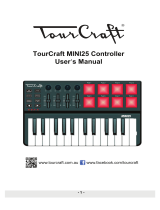
E 3
Table of contents
Introduction ...........................................2
minilogue Key Features .................................. 2
Block Diagram .................................................... 3
Controls and Connections ....................4
Front Panel Controls ........................................ 4
Rear Panel Connections .................................. 5
Turning the minilogue On and O ............. 6
Playing Programs and Sequences ........8
Selecting and Playing a Program ................ 8
Using Favorites .................................................. 9
Playing the Sequencer ..................................11
Programs ............................................. 12
Program Architecture .................................... 12
Creating Sounds ..............................................13
Saving a Program ............................................14
Basic Parameter Editing ................................15
Voice modes .....................................................24
Sequencer .......................................................... 26
Edit Mode ............................................ 32
How to enter the Edit mode .......................32
PROGRAM EDIT mode ...................................34
SEQ EDIT mode ................................................39
GLOBAL EDIT mode ........................................42
MICROTUNING mode ....................................49
Other functions ................................... 51
Tuning .................................................................51
Restoring the Factory settings ...................53
Shortcuts using the SHIFT button ............. 54
Understanding MIDI ........................... 56
Connecting Devices via MIDI and USB ....56
MIDI-Related Settings ....................................58
Program List ........................................ 60
Specications ...................................... 62
MIDI Implementation Chart ............... 63




















